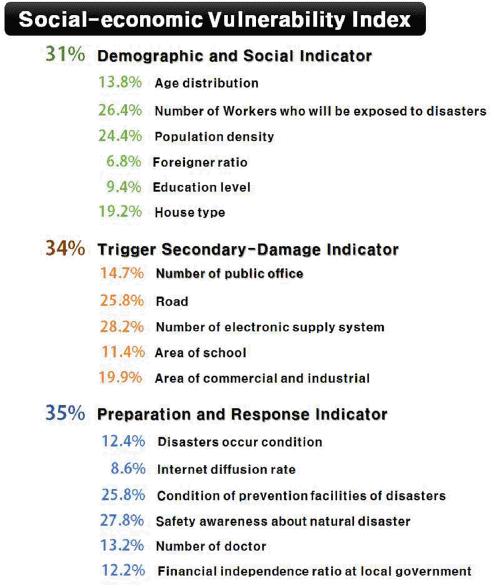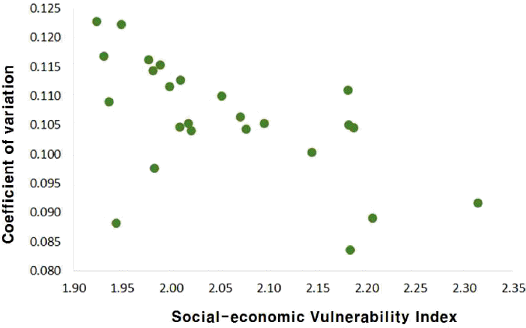Carreňo, M.L, Cardona, O.D, and Barbar, A.H (2007) A disaster risk management perfomance index.
Natural Hazards, Vol. 41, No. No. 1, pp. 1-20. 10.1007/s11069-006-9008-y.

Dwyer, A, Zoppou, C, Nielsen, O, Day, S, and Roberts, S (2004)
Quantifying Social Vulnerability: A methodology for identifying those at risk to natural hazards, Australian Government, Geoscience Australia.

Eakin, H, and Bojórquez-Tapia, L.A (2008) Insights into the composition of household vulnerability from multicriteria decision analysis.
Global Environmental Change, Vol. 18, pp. 112-127. 10.1016/j.gloenvcha.2007.09.001.

Eidsvig, U.M.K, Mc Lean, A, Vangelsten, B.V, Kalsnes, B, Ciurean, R.L, Argyroudis, S, Vinter, M.G, Mavrouli, O.C, Fotopoulou, S, Pitilakis, K, Baills, A, Malet, J.-B, and Kaiser, G (2014) Assessment of socioeconomic vulnerability to landslide using an indicator-based approch: methodology and cse studies.
Bulletin of Engineering Geology and the Environment, Vol. 73, pp. 307-324. 10.1007/s10064-014-0571-2.

Galli, M, and Guzzetti, F (2007) Landslide vulnerability criteria: A case study from Umbria, Central Italy.
Environ Manage, Vol. 40, pp. 649-664. 10.1007/s00267-006-0325-4. 17638046.


Kim, D, Jung, Y, Park, M.J, Yoon, J.Y, Kim, S, and Choi, M (2011) Vulnerability analysis of water resources considering climate change.
Journal of Korea Wetland Society, Vol. 13, No. No. 1, pp. 25-33.

Kim, H.S, Park, G.J, Kim, S.D, Choi, M.H, Pakr, M.J, and Yoon, J.Y (2012) Assessment of flood vulnerability considering climate change and large-scale river restoration project.
Journal of korea society of hazard mitigation, Vol. 12, No. No. 2, pp. 107-113.

Lahidji, R (2008) Risk assessment and mitigation measures for natural and conflict-related hazards in Asia Pacific, Appendix G, Measuring the capacity to cope with natural disasters.
Contribution to the UN OCHA project.

Li, Z, Nadim, F, Huang, H, Uzielli, M, and Lacasse, S (2010) Quantitative vulnerability estimation for scenario-based landslide hazards.
Landslides, Vol. 7, No. No. 2, pp. 125-134. 10.1007/s10346-009-0190-3.

Lee, H.-N, and Yang, S.-W (2011) The effect of the residential environment evaluation on the housing type preference.
Journal of Architectural Institute of Korea, Vol. 27, No. No. p, pp. 261-270.

National Emergency Management Agency(NEMA) (2013).
2013 Disaster annual report.

Park, Y, Jeong, S, and Kim, S (2014) Natural disaster vulnerability assessment at boroughs and census output areas in seoul focusing on socio-economic perspective.
Journal of Korea Society of Hazard Mitigation, Vol. 14, No. No. 6, pp. 439-449. 10.9798/KOSHAM.2014.14.6.439.

Saaty, T.L (2008) Decision making with the analytic hierarchy process.
International Journal of Services Sciences, Vol. 1, No. No. 1, pp. 83-98. 10.1504/IJSSCI.2008.017590.

Safeland, (2012)
Living with landslide risk in Europe: Assessment, effects of global change, and risk management strategies, Deliverable D2.6 Methodology for evaluation of the socio-economic impact of landslides(socio-economic vulnerability).

Siagian, T.H, Purhadi, P, Suhartono, S, and Ritonga, H (2014) Social vulnerability to natural hazards in Indonesia: driving factors and policy implications.
Nat Hazards, Vol. 70, pp. 1603-1617. 10.1007/s11069-013-0888-3.

Sim, O.B, Lee, B.J, Lee, C.H, and Kim, J.H (2013) A study on the methods to analyze climate change driven urabn disasster vunlnerablility for disaster preventive urban planning.
Journal of Korea Society of Hazard Mitigation, Vol. 13, No. No. 6, pp. 239-247. 10.9798/KOSHAM.2013.13.6.239.

Smith, K, and Ward, R (1998).
Floods: physical processes and human impacts. Chichester: Wiley.

Yeo, C-g, Lee, S. O, Song, J-w, and Kim, Y. J (2008). Characteristic analysis of damaged buildings’ due to flood for urban evacuation plan.
Conference of Korean Society of Civil Engineers. pp. 3665-3668.















